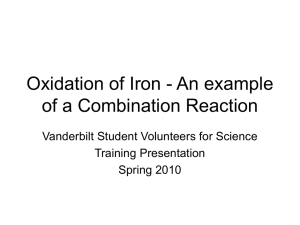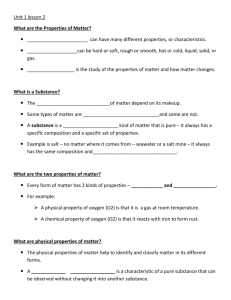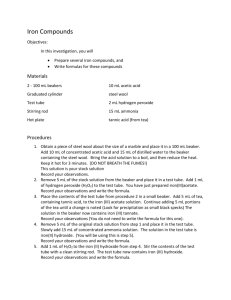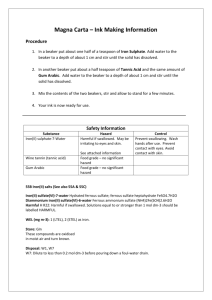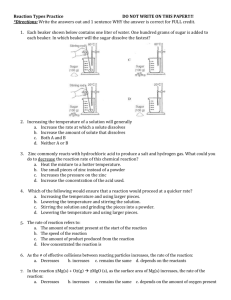Doc - Beyond Benign
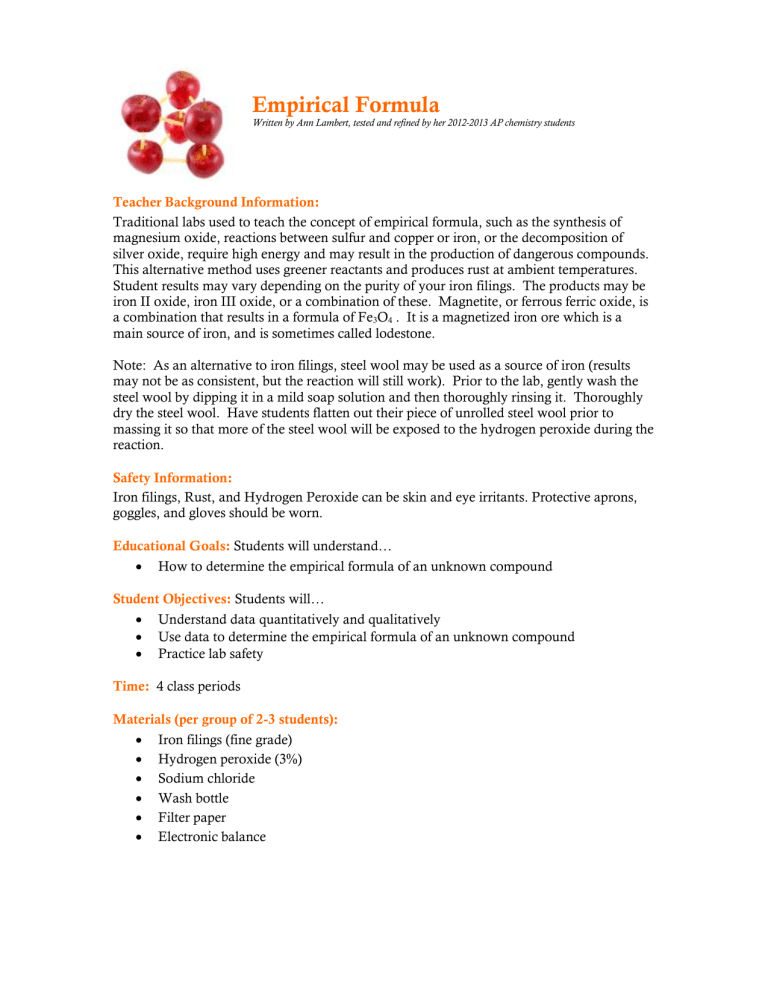
Empirical Formula
Written by Ann Lambert, tested and refined by her 2012-2013 AP chemistry students
Teacher Background Information:
Traditional labs used to teach the concept of empirical formula, such as the synthesis of magnesium oxide, reactions between sulfur and copper or iron, or the decomposition of silver oxide, require high energy and may result in the production of dangerous compounds.
This alternative method uses greener reactants and produces rust at ambient temperatures.
Student results may vary depending on the purity of your iron filings. The products may be iron II oxide, iron III oxide, or a combination of these. Magnetite, or ferrous ferric oxide, is a combination that results in a formula of Fe
3
O
4
. It is a magnetized iron ore which is a main source of iron, and is sometimes called lodestone.
Note: As an alternative to iron filings, steel wool may be used as a source of iron (results may not be as consistent, but the reaction will still work). Prior to the lab, gently wash the steel wool by dipping it in a mild soap solution and then thoroughly rinsing it. Thoroughly dry the steel wool. Have students flatten out their piece of unrolled steel wool prior to massing it so that more of the steel wool will be exposed to the hydrogen peroxide during the reaction.
Safety Information:
Iron filings, Rust, and Hydrogen Peroxide can be skin and eye irritants. Protective aprons, goggles, and gloves should be worn.
Educational Goals: Students will understand…
How to determine the empirical formula of an unknown compound
Student Objectives: Students will…
Understand data quantitatively and qualitatively
Use data to determine the empirical formula of an unknown compound
Practice lab safety
Time: 4 class periods
Materials (per group of 2-3 students):
Iron filings (fine grade)
Hydrogen peroxide (3%)
Sodium chloride
Wash bottle
Filter paper
Electronic balance
Procedure:
Guide the students through the steps of the procedure. Encourage the students to draw conclusions based upon the data they collect. The experiment will take only a small portion of the class period over the four day period.
Day 1
1.
Mass approximately 0.5 g of iron filings.
2.
Place the iron filings into a 250 mL beaker.
3.
Fill with 100.0 mL of 3% hydrogen peroxide covering the iron filings.
4.
Add a pinch of sodium chloride to the solution to provide the electrolyte for the reaction.
5.
Wait a day for the reaction to occur.
Day 2
1. Stir the contents of the beaker and look for additional bubbles (indicating there is still unreacted iron present).
2. Add an additional 30.0 mL of 3% hydrogen peroxide to the content of the beaker.
3. Stir the contents and allow to sit another day. (Be sure to rinse the stirring rod into the beaker in order to be sure none of the iron or rust is removed from the beaker.)
Day 3
1. Mass a piece of filter paper.
2. Filter the contents of the beaker. Use the wash bottle to rinse the small particles left at the bottom of the beaker into the filter.
3. Thoroughly rinse the precipitate on the filter paper with water.
4. Allow the filter paper to dry.
Day 4
Students will then mass the paper and its contents. Students will use data to determine the mass of Fe, mass of rust and mass of O. They will then calculate the number of moles of Fe and of O by diving each by its atomic mass and calculate the mole ratio of Fe to O by diving each by the smaller number of moles. This information will enable the students to determine the empirical formula of the rust compound.
Answers for the discussion questions:
What kind of a reaction is this?
Synthesis or Composition or Redox
What are possible errors for this experiment?
Student answers will vary depending on the results. Possible answers include unreacted iron, failure to transfer all of the rust to the filter paper, etc.
How does the salt help the reaction take place?
It provides the electrolyte for the redox reaction to proceed more quickly.
Which principles of green chemistry does this lab experiment meet?
3 – Less hazardous chemical synthesis
6 – Design for energy efficiency
12 –Inherently safer chemistry for accident prevention
Empirical Formula
Student Lab Sheet
Materials:
Iron filings (fine grade)
Hydrogen peroxide (3%)
Sodium chloride
Wash bottle
Filter paper
Electronic balance
Procedure:
Day 1
1.
Mass approximately 0.5 g of iron filings.
2.
Place the iron filings into a 250 mL beaker.
3.
Fill with 100.0 mL of 3% hydrogen peroxide covering the iron filings.
4.
Add a pinch of sodium chloride to the solution to provide the electrolyte for the reaction.
5.
Wait a day for the reaction to occur.
Day 2
1.
Stir the contents of the beaker and look for additional bubbles (indicating there is still unreacted iron present).
2.
Add an additional 30.0 mL of 3% hydrogen peroxide to the content of the beaker.
3.
Stir the contents and allow to sit another day. (Be sure to rinse the stirring rod into the beaker in order to be sure none of the iron or rust is removed from the beaker.
Day 3
1.
Mass a piece of filter paper.
2.
Filter the contents of the beaker. Use the wash bottle to rinse the small particles left at the bottom of the beaker into the filter.
3.
Thoroughly rinse the precipitate on the filter paper with water.
4.
Allow the filter paper to dry.
Day 4
1.
Mass the paper and its contents.
Sample Data Table a. Mass of weigh boat b. Mass of weigh boat with iron filings c. Mass of filter paper d. Mass of filter paper with dried rust
Calculations:
1. mass of Fe = mass b. - mass a.
2. mass of rust = mass d. - mass c.
3. mass of O = mass of rust - mass of Fe
4. Calculate the number of moles of Fe and of O by diving each by its atomic mass
5. Calculate the mole ratio of Fe to O by diving each by the smaller number of moles
6. Determine the empirical formula of the rust compound.
Discussion questions:
1.
What kind of a reaction is this?
2.
What are possible errors for this experiment?
3.
What is the equation for the reaction that occurred?
4.
How does the salt help the reaction take place?

